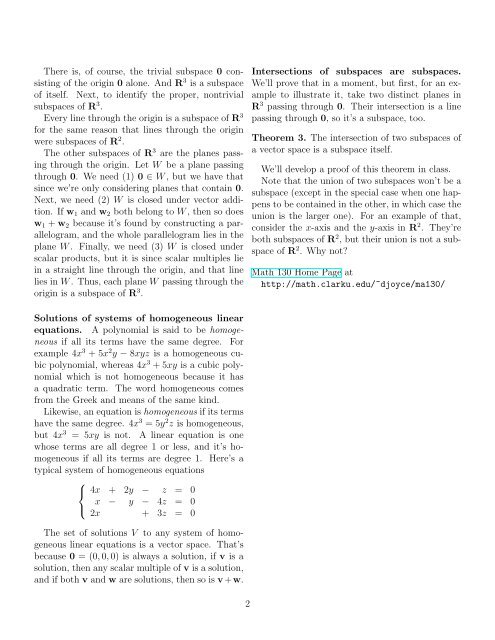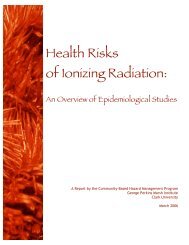Subspaces of Vector Spaces Math 130 Linear Algebra
Subspaces of Vector Spaces Math 130 Linear Algebra
Subspaces of Vector Spaces Math 130 Linear Algebra
Create successful ePaper yourself
Turn your PDF publications into a flip-book with our unique Google optimized e-Paper software.
There is, <strong>of</strong> course, the trivial subspace 0 consisting<br />
<strong>of</strong> the origin 0 alone. And R 3 is a subspace<br />
<strong>of</strong> itself. Next, to identify the proper, nontrivial<br />
subspaces <strong>of</strong> R 3 .<br />
Every line through the origin is a subspace <strong>of</strong> R 3<br />
for the same reason that lines through the origin<br />
were subspaces <strong>of</strong> R 2 .<br />
The other subspaces <strong>of</strong> R 3 are the planes passing<br />
through the origin. Let W be a plane passing<br />
through 0. We need (1) 0 ∈ W , but we have that<br />
since we’re only considering planes that contain 0.<br />
Next, we need (2) W is closed under vector addition.<br />
If w 1 and w 2 both belong to W , then so does<br />
w 1 + w 2 because it’s found by constructing a parallelogram,<br />
and the whole parallelogram lies in the<br />
plane W . Finally, we need (3) W is closed under<br />
scalar products, but it is since scalar multiples lie<br />
in a straight line through the origin, and that line<br />
lies in W . Thus, each plane W passing through the<br />
origin is a subspace <strong>of</strong> R 3 .<br />
Intersections <strong>of</strong> subspaces are subspaces.<br />
We’ll prove that in a moment, but first, for an example<br />
to illustrate it, take two distinct planes in<br />
R 3 passing through 0. Their intersection is a line<br />
passing through 0, so it’s a subspace, too.<br />
Theorem 3. The intersection <strong>of</strong> two subspaces <strong>of</strong><br />
a vector space is a subspace itself.<br />
We’ll develop a pro<strong>of</strong> <strong>of</strong> this theorem in class.<br />
Note that the union <strong>of</strong> two subspaces won’t be a<br />
subspace (except in the special case when one happens<br />
to be contained in the other, in which case the<br />
union is the larger one). For an example <strong>of</strong> that,<br />
consider the x-axis and the y-axis in R 2 . They’re<br />
both subspaces <strong>of</strong> R 2 , but their union is not a subspace<br />
<strong>of</strong> R 2 . Why not?<br />
<strong>Math</strong> <strong>130</strong> Home Page at<br />
http://math.clarku.edu/~djoyce/ma<strong>130</strong>/<br />
Solutions <strong>of</strong> systems <strong>of</strong> homogeneous linear<br />
equations. A polynomial is said to be homogeneous<br />
if all its terms have the same degree. For<br />
example 4x 3 + 5x 2 y − 8xyz is a homogeneous cubic<br />
polynomial, whereas 4x 3 + 5xy is a cubic polynomial<br />
which is not homogeneous because it has<br />
a quadratic term. The word homogeneous comes<br />
from the Greek and means <strong>of</strong> the same kind.<br />
Likewise, an equation is homogeneous if its terms<br />
have the same degree. 4x 3 = 5y 2 z is homogeneous,<br />
but 4x 3 = 5xy is not. A linear equation is one<br />
whose terms are all degree 1 or less, and it’s homogeneous<br />
if all its terms are degree 1. Here’s a<br />
typical system <strong>of</strong> homogeneous equations<br />
⎧<br />
⎨<br />
⎩<br />
4x + 2y − z = 0<br />
x − y − 4z = 0<br />
2x + 3z = 0<br />
The set <strong>of</strong> solutions V to any system <strong>of</strong> homogeneous<br />
linear equations is a vector space. That’s<br />
because 0 = (0, 0, 0) is always a solution, if v is a<br />
solution, then any scalar multiple <strong>of</strong> v is a solution,<br />
and if both v and w are solutions, then so is v +w.<br />
2
















